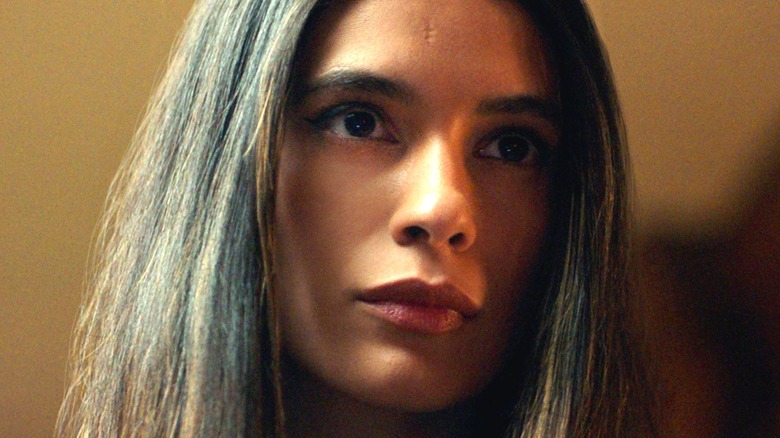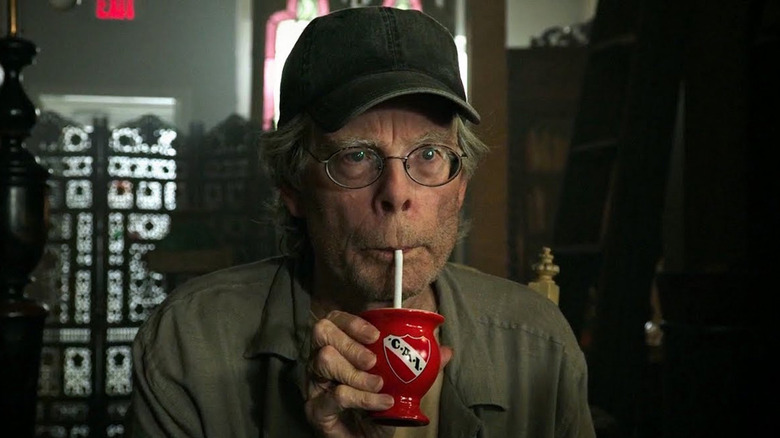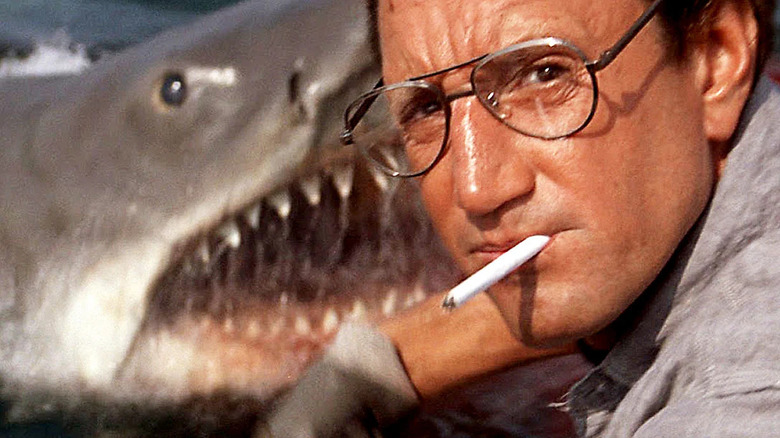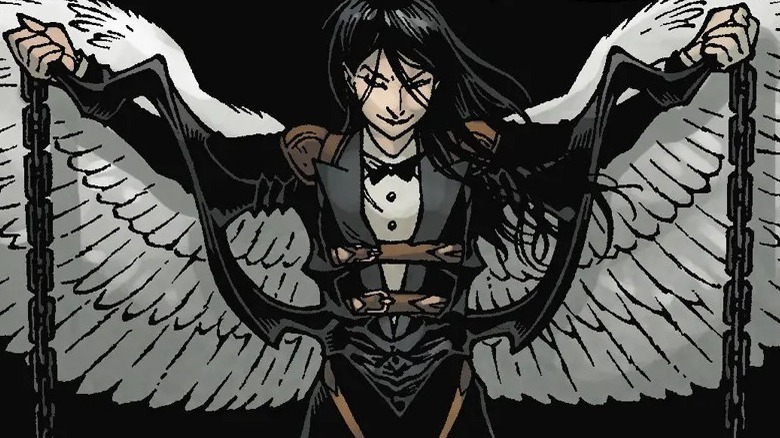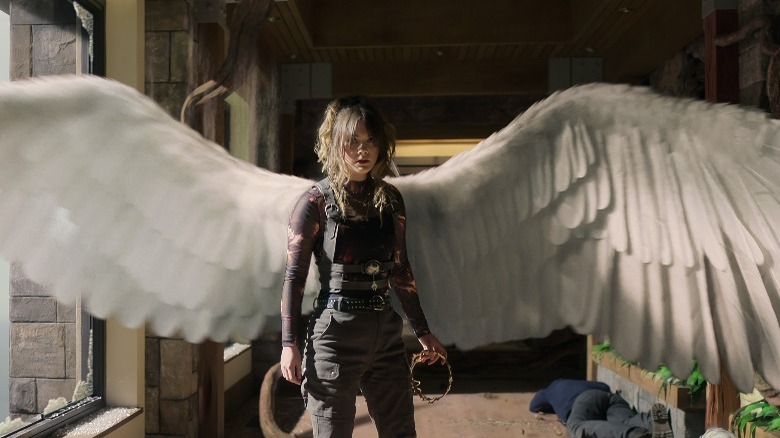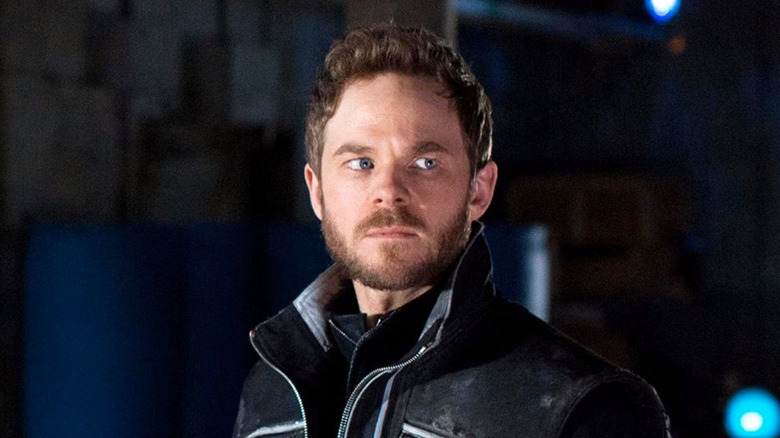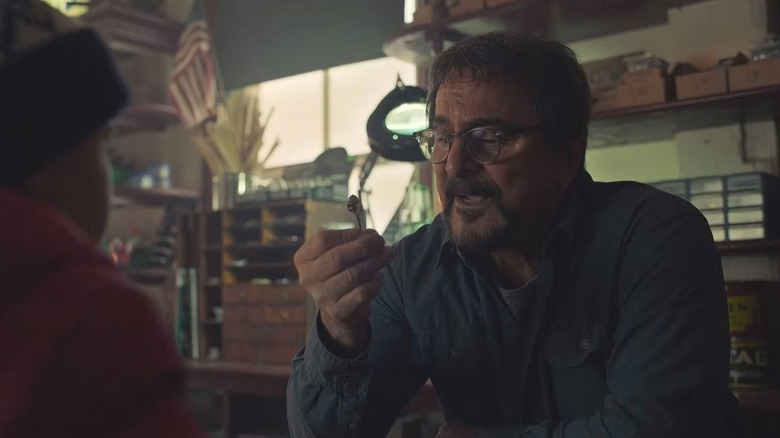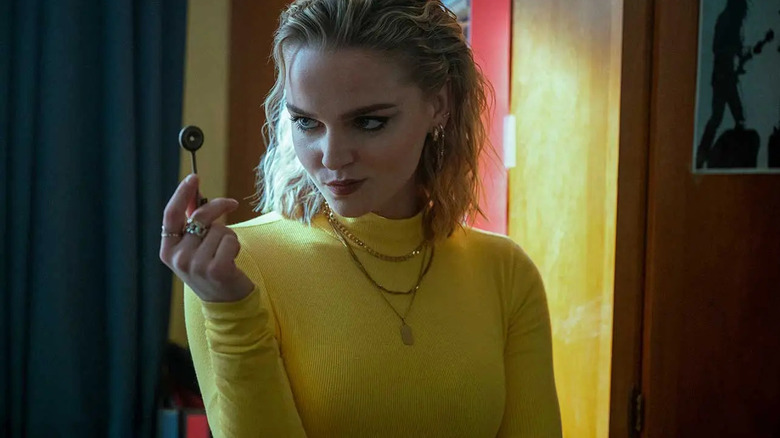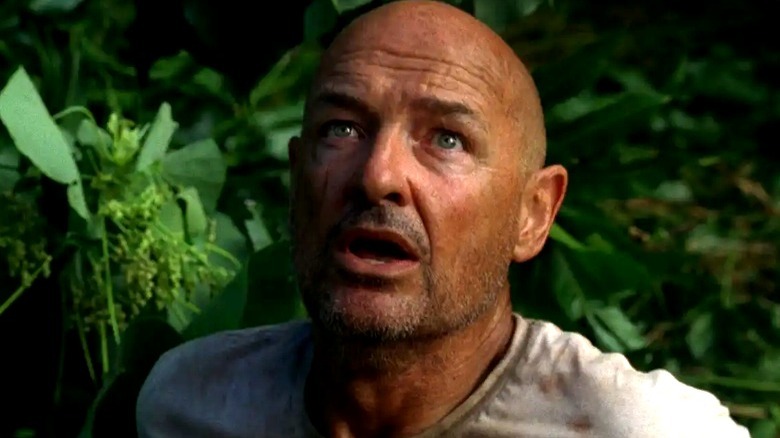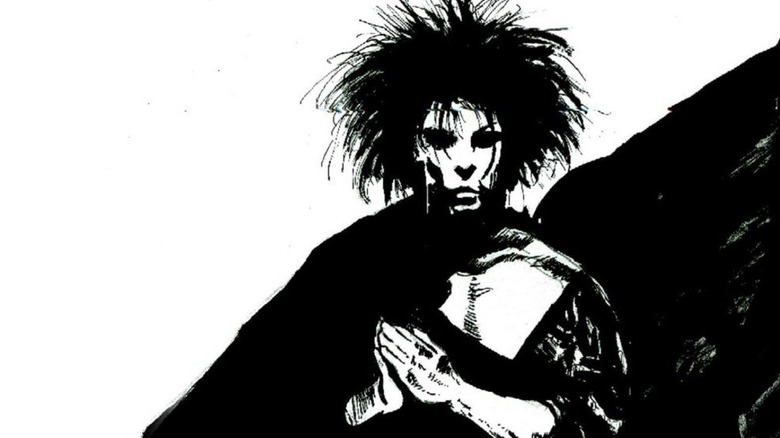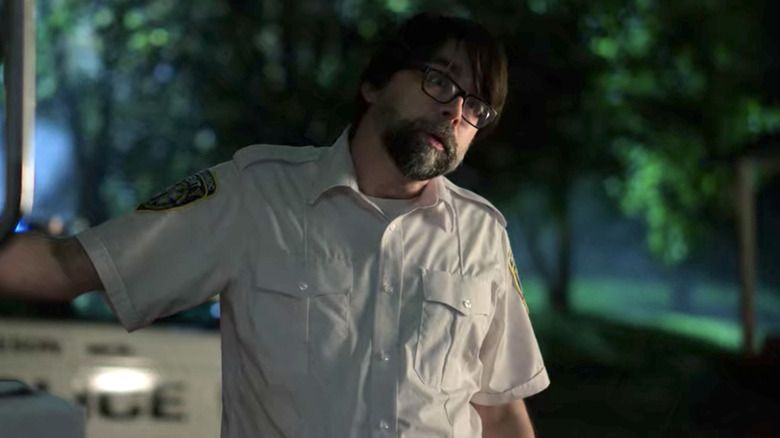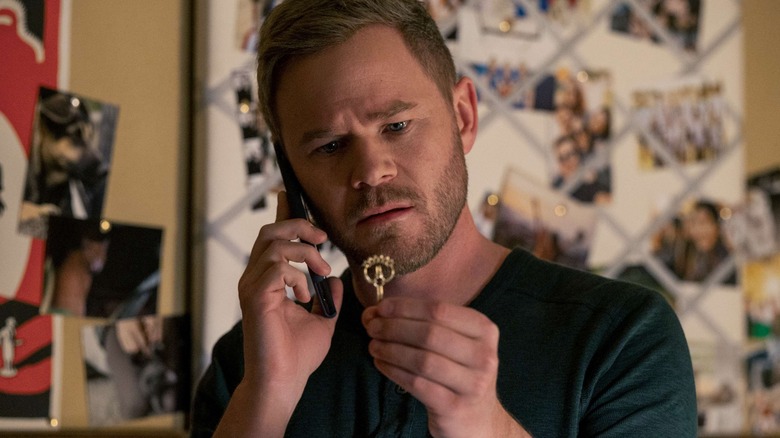The Untold Truth Of Locke & Key
Netflix has become a haven for horror fans over the last few years, with a whole shambling horde of original creepy content. One of its star series is "Locke & Key," a supernatural horror show adapted from the popular comic of the same name by Joe Hill and Gabriel Rodríguez. Over three increasingly thrilling seasons, the series has explored the Locke family and the mysterious Keyhouse they're fated to inherit. True to its name, the house comes with a series of keys, and all of them are magical and terrifying. The show, however, is about more than just the overtly pun-tastic Locke family and their keys –- its story, as well as the stories behind its adaptation for television — not to mention the show's connection to other series — are intricate and interesting.
Like the titular Keyhouse, the actual story behind "Locke & Key" is labyrinthine, full of twists, turns, and doors that go anywhere but the place you'd expect. It may surprise you to know that some of those doors lead to other "Locke & Key" shows, an actor mistaken for their twin, and even a legendary real-life cold case. To explore those surprising spaces and more, here is the untold truth of "Locke & Key."
From horror royalty
Most fans of comic creator Hill will know his historic lineage, but for fans who jumped onboard the time-traveling, teleporting train that is "Locke & Key" through the Netflix series, they might have never even heard of him. Even if fans do pay enough attention to the credits to see Hill's name, it is an exceptionally unremarkable one –- which is just how Hill wanted it. When Hill decided to become a fiction writer, he opted not to use his famous father's name and instead forge his own path. That's why he chose Joe Hill, a shortened version of his birth name, Joseph Hillström King. Hill's father is none other than horror icon Stephen King.
For many who learn about Hill's parentage, the reveal is a surprise –- but only momentarily. After all, Hill's work bears a striking resemblance to King's, just as Hill bears a striking resemblance to his famous father. Both authors write primarily horror, tend to set their stories in and around Maine, often feature children as protagonists, use magical children as plot points, and positively love flashing back in time. If you want to see some proof of those familiarities, just compare "Locke & Key" to "It" on these points.
A 50-year-old cold case
As strange as it sounds, Hill actually plays a role in the attempted solving of a murder case that has gone unsolved for 50 years — a real, nonfiction murder case. The murder in question is the infamous "Lady of the Dunes," a Jane Doe found in Provincetown, Massachusetts all the way back in 1974. The particularly brutal way in which she was murdered, combined with various other factors like the location of the body and how long it took to be discovered, have led to the Lady of the Dunes being referred to as the "Holy Grail" of cold cases by The True Crime Edition. And though she remains unidentified after roughly fifty years, an interesting lead in the case arose as recently as 2015 –- and it was all thanks to Hill.
As The AV Club reports, While watching "Jaws," Hill noticed an extra in the film who matched the physical description of the Lady of the Dunes and even wore some of the same clothing that the Lady was wearing when she was found. Lending plausibility to Hill's observation is the fact that "Jaws" was filmed in Cape Cod (the area in which Provincetown is located) at the very same time as the Lady was discovered: the summer of 1974. So far, the observation hasn't led to any positive identification, but even if it ends up completely fruitless, it is still impressive attention to detail on Hill's part.
A meteoric rise to success
The original comic book version of "Locke & Key" quickly became, and still remains, a massive hit. Based on its award nominations and wins, sales numbers, and its many adaptations and tie-ins, the series is an all-around success. However, even more impressive than its excellent performance is the fact that "Locke & Key" is Joe Hill's very first comic.
The comic began in 2008, at an extremely early point in Hill's career. He had published one novel and a collection of short stories in the previous few years, and that was it. That makes meteoric the only term capable of describing the immediate, sweeping success of "Locke & Key."
The comic earned Hill an Eisner Award for best writer. It's also garnered nominations and wins from some of the most prestigious genre awards in the industry, including two nominations for Hugo Awards and a win at the British Fantasy Awards. In addition, the comic has led to tie-in comic series, crossovers, a card game, an audio play, and of course -– a widely loved adaption at Netflix.
Not the first Locke and Key series
As any comic creator can tell you, turning a comic, even a beloved and long-running series like "Locke & Key," into a series for streaming is tough. The process is long, arduous, and involves red tape and compromise the whole way through. Even when the process seems finished and episodes are made, the series can be canceled on a whim – just ask Rick Remender about the canceled Syfy adaptation of "Deadly Class" or Brian K. Vaughan about the Hulu adaptation of "Y: The Last Man." Hill and Rodríguez's "Locke & Key" is no exception, and the road to its successful run on Netflix was long and winding.
The long journey from comic to series began at least as early as 2010 when IDW Publishing sold the film and TV rights to the first interested studio -– the first of many such transfers. The project changed studios, crew, and cast, eventually landing at Fox, which actually produced a finished pilot for the series, and even screened the pilot at Comic-Con, per Deadline. The series wasn't picked up, however, and more studios and creatives signed on for several attempts to get a "Locke & Key" adaptation made, most notably Hulu, as Variety reported in 2017. That series failed to launch as well, and ultimately, an adaptation would have to wait until 2020 to actually materialize. That adaptation is, of course, the current Netflix series.
That's not Iceman
One of the series's most important characters is Duncan Locke, brother to the late Rendell Locke and uncle of the main trio of Tyler, Kinsey, and Bode. After Rendell's chilling death, Uncle Duncan steps in the help Rendell's widow Nina and the children acclimate to their new home in Matheson, Massachusetts. As the series progresses, Duncan's importance to the overarching story grows exponentially, including him moving into the Keyhouse and -– major spoiler alert -– learning to create his own magic keys. If Duncan looks familiar to you, there's a very good reason for that. In fact, due to one very rare situation, there are actually two good reasons for that fact — Duncan is played by actor Aaron Ashmore, the identical twin of actor Shawn Ashmore.
Aside from "Locke & Key," Aaron is best known for his role as Jimmy Olsen on "Smallville," as well as a few cult-classic genre series, including "Warehouse 13" and "Killjoys." Shawn, on the other hand, is the Ashmore who played Iceman in the Fox "X-Men" films and more recently Lamplighter in "The Boys." The two truly are identical, and it makes the face they share twice as recognizable as it would be with only one Ashmore active in Hollywood.
Love for Tom Savini
Fans of classic horror movies and TV series will likely be familiar with a few legends of the genre such as Wes Craven, John Carpenter, George Romero, and, of course, Tom Savini. Savini has worked in the genre for around fifty years and has done it all, from acting and stunt work to directing. His most iconic contribution to horror throughout the years, however, has been his almost unrivaled advancement in special effects, makeup, and masks, as detailed in an interview with Independent. Savini played a large part in creating the look of movies like "Dawn of the Dead," "Friday the 13th," and "Creepshow." Hill, a lifelong fan and creator of horror, decided to pay tribute to Savini in "Locke & Key" in a couple of different ways.
The first is within the storyline. When the misfit Locke child Kinsey finds a group of equally awkward friends, she quickly realizes that they're absolutely obsessed with horror. So obsessed that they call themselves the "Savini Squad" and even explain Savini's status as a legend to Kinsey. They film bloody, effects-drive horror films for fun, always citing Savini or his work in the process. The second way in which Savini gets his due is in Season 1, Episode 2, when he cameos as the town locksmith, studying one of the Keyhouse's notorious keys.
Whole new keys
As witty and multi-layered as Hill, showrunners Carlton Cuse and Meredith Averill, and the rest of the "Locke & Key" creative team is, there is no escaping the surface-level plot common to both the comic and series: "Locke & Key" features a lot of locks and a lot of keys. For all the deeper meanings of the two symbolic items, and despite the punny name of the main house and family, the story also depends on, quite simply, a lot of literal keys. However, despite how central the magic keys are to the story and its characters, the roster of keys actually changed quite a bit from comic book to TV series.
At least some of the changes made to the keys seem to be due to differences between comic creators and series writers, as they all have their own favorite keys -– both as fans and as storytellers. Speaking with Black Nerd Problems, Cuse spoke about his enthusiasm for the storytelling opportunities presented by the Head Key, while Averill noted that he particularly enjoyed being able to introduce the Small World Key. Meanwhile, Hill said that the Ghost Key was a favorite, while Rodriguez was partial to the Anywhere Key. Regardless of the reasons why many keys were changed. Most notable are the Head Key, which operates completely differently (with much less ickiness)in the show, and the Skin Key, which was made by combining the Skin Key and Gender Key.
Major ties to other shows
Easter eggs, homages, and crossovers are common in TV series, especially in genres like sci-fi, fantasy, and horror. After all, if your setting is full of magic, then the idea of magical entities from other franchises -– like, say, "The Sandman" -– visiting that setting is a relatively easy pill to swallow. Lucky for fans, "Locke & Key" follow suit, connecting to various other shows and franchises, both in canon and behind the scenes.
One of the more coincidental connections comes as a result of one location where "Locke & Key" is filmed: Lunenburg, Nova Scotia. Some fans may already recognize the town, as just off of Lunenburg's coast sits Oak Island, home to the infamous Oak Island Mystery and setting for the History series "The Curse of Oak Island."
One of the other more prevalent connections comes behind the scenes, specifically surrounding Cuse and the most widely known series he worked on, "Lost." The Keyhouse is a magical location that distorts space and time around it, just like the island from "Lost." Also, like the island –- and here is where Cuse's influence likely comes into play –- bodiless whispers guide the inhabitants to locations that help them achieve their destinies, for better or worse. Another fun coincidence on top of that is that in "Lost," the island primarily whispers to a character named Locke.
Just one part of a growing franchise
We briefly mentioned before that the original "Locke & Key" comic has led to more tie-ins beyond the Netflix show. However, unless you've followed the franchise since its inception over a decade ago, you probably aren't aware of just how far its begun to spread its Lovecraftian tentacles.
For a comic book, especially a non-superhero, non-Marvel, Non-DC comic book, to reach a level of success that leads to product tie-ins, you know it's something special. Aside from a few standouts like "Judge Dredd" and "The Walking Dead," it's an extremely rare feat. And yet "Locke & Key" managed to court a whole host of production companies and networks, including Fox, Hulu, and Netflix, who vied to adapt it for the screen.
It also made the leap to the tabletop in the form of "Locke & Key: The Game," a tabletop board game that incorporates cards, as well as the leap to Audible with the "Locke & Key" audio drama. The series even crossed over with the legendary "The Sandman" comics, and its popularity inspired Hill to relaunch the series again after the main storyline concluded, leading to a number of standalone issues being released.
Creator cameos
Stephen King is notorious for popping up in cameo roles whenever one of his stories is adapted for the big screen. He's done it a ton of times and hasn't shown any indication he's going to stop any time soon. In this case, the apple doesn't fall far from the tree, and the first chance Hill got, he made a cameo in one of his adaptations. The cameo in question happens in Episode 10 of "Locke & Key," Season 1, and actually involved both Hill and his co-creator Rodriguez.
At a certain point in the episode, which is the Season 1 finale, Bode's friend Rufus gets knocked out. A pair of paramedics arrive to strap Rufus onto a gurney and drive him away in their ambulance. Fans may not realize it, but those paramedics are played by Hill and Rodriguez. Even more interesting than their cameo is its comic book basis -– Rodriguez actually drew himself and Hill into the original comic as paramedics, as well, making their live-action Netflix cameos a true nod to longtime fans. As Averill told The Hollywood Reporter, "We recalled that Gabe, in this very meta way, had drawn a panel in which he and Joe played paramedics in the graphic novel. So, how much more meta can we get?"
A planned conclusion
As bittersweet as it is to say, the Netflix adaptation of "Locke & Key" ends at the close of Season 3. The source of the bitterness is obvious: if you're a fan of the show, you likely don't want it to end. It's hard to become entrenched in a world only for it to end, just as it's hard to become close to characters only for them to leave forever. However, there is a sweetness to the "Locke & Key" ending, too, with potentially more sweetness to come down the road.
One spoonful of sugar that will help the medicine go down is that the team behind the show always intended it to run for three seasons and stop there. As Cuse and Averill told Deadline, "Once we began working on the series, we felt three seasons was the ideal length to bring the story of the Locke family and their Keyhouse adventures to a satisfying conclusion." The original comic only ran for 37 issues, so 30 episodes is a fitting number.
The other bit of good news is that — partially in response to the success of the original "Locke & Key" comic and the Netflix show — Hill has returned to his world of locks, Lockes, and keys, writing issue after issue for the last few years. With that in mind, the possibility of Netflix reviving "Locke & Key" to tell these newly-written stories is tantalizing.
